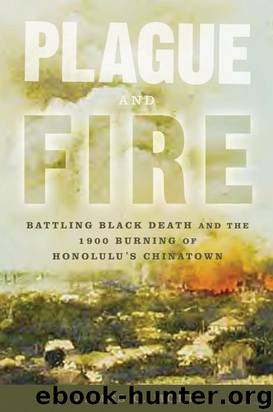Plague and Fire by James C. Mohr

Author:James C. Mohr [Mohr, James C.]
Language: eng
Format: epub
Publisher: Oxford University Press
Published: 2004-11-15T08:00:00+00:00
In his reply, Wood denied the intentional destruction of any Japanese goods and denied "there been any ill treatment of the Japanese of any kind." On the basis of reports reaching him from physicians on the scene, Wood asserted that it was "utterly untrue that men and women have been put in one line naked at the time of disinfection. The men and women have been entirely separated at the time of giving the disinfecting baths." But he did concede that "some trouble has been made by a few Japanese men, keepers of, or residents at, the bagnios [brothels] of Pauahi Street. The respectable class of Japanese, however, have worked with the agents of the Board in the utmost harmony." President Wood and his two colleagues on the Board fully realized that the agents acting in their name were a mixed lot, some of whom no doubt thoroughly enjoyed playing the role of petty tyrant. To avoid future embarrassment, the three physicians quietly began hiring matrons to attend female refugees in the camps.18
The Board continued to meet every morning and almost every afternoon, seven days a week. Every day brought news of another death inside Chinatown; up to five people died on bad days. Hoffman, the Board's bacteriologist, performed autopsies virtually around the clock, and the city's refurbished crematorium was in nearly continuous use. Most of the victims were Chinese and Japanese; a few were Hawaiian. Some people in the city became convinced that pestis lived mainly in Asian foodstuffs, or could at least survive in Asian food and be spread when eaten. After all, with the exception of Ethel Johnson, people who ate Western foods were still unaffected by the epidemic, while those who died had eaten mostly Asian foods. And the papers all noted that Ethel had been eating Chinese candy she bought at an Asian market shortly before she came down with plague. So the Board had to spend a great deal of time debating whether or not to fumigate, destroy, or ban foods imported from Asia. The Board's first order of business, however, remained the ongoing condemnation of specific plague sites, as reported by Citizens' Sanitary Commission inspectors, confirmed by the Board's authorized physicians, and formally voted by Emerson, Day, and Wood persona Ily.9
The fire department spent almost every day executing the Board's orders, usually running one or two days behind the formal condemnations. As a practical matter, burning specific sets of buildings, even burning separate blocks, was a difficult and dangerous task. The overwhelming majority of structures in Chinatown were wood, most were packed densely together, and many were quite flimsily constructed. Every fire had the potential to spread beyond its intended target, as accidental fires had regularly done in previous years, sometimes with disastrous results. The worst of those accidental conflagrations had occurred in 1886, when a runaway kitchen fire in a Chinese boardinghouse destroyed most of Chinatown below Beretania Street and triggered mob violence by Hawaiians against Chinese, whom the Hawaiians of the district blamed for their losses.
Download
This site does not store any files on its server. We only index and link to content provided by other sites. Please contact the content providers to delete copyright contents if any and email us, we'll remove relevant links or contents immediately.
| Africa | Americas |
| Arctic & Antarctica | Asia |
| Australia & Oceania | Europe |
| Middle East | Russia |
| United States | World |
| Ancient Civilizations | Military |
| Historical Study & Educational Resources |
Cat's cradle by Kurt Vonnegut(15182)
Pimp by Iceberg Slim(14393)
4 3 2 1: A Novel by Paul Auster(12281)
Underground: A Human History of the Worlds Beneath Our Feet by Will Hunt(12022)
The Radium Girls by Kate Moore(11921)
Wiseguy by Nicholas Pileggi(5671)
Perfect Rhythm by Jae(5324)
American History Stories, Volume III (Yesterday's Classics) by Pratt Mara L(5256)
The Fire Next Time by James Baldwin(5248)
Paper Towns by Green John(5088)
Pale Blue Dot by Carl Sagan(4912)
A Higher Loyalty: Truth, Lies, and Leadership by James Comey(4843)
The Mayflower and the Pilgrims' New World by Nathaniel Philbrick(4421)
The Doomsday Machine by Daniel Ellsberg(4415)
Killers of the Flower Moon: The Osage Murders and the Birth of the FBI by David Grann(4385)
The Sympathizer by Viet Thanh Nguyen(4305)
Too Much and Not the Mood by Durga Chew-Bose(4272)
The Borden Murders by Sarah Miller(4247)
Sticky Fingers by Joe Hagan(4100)
